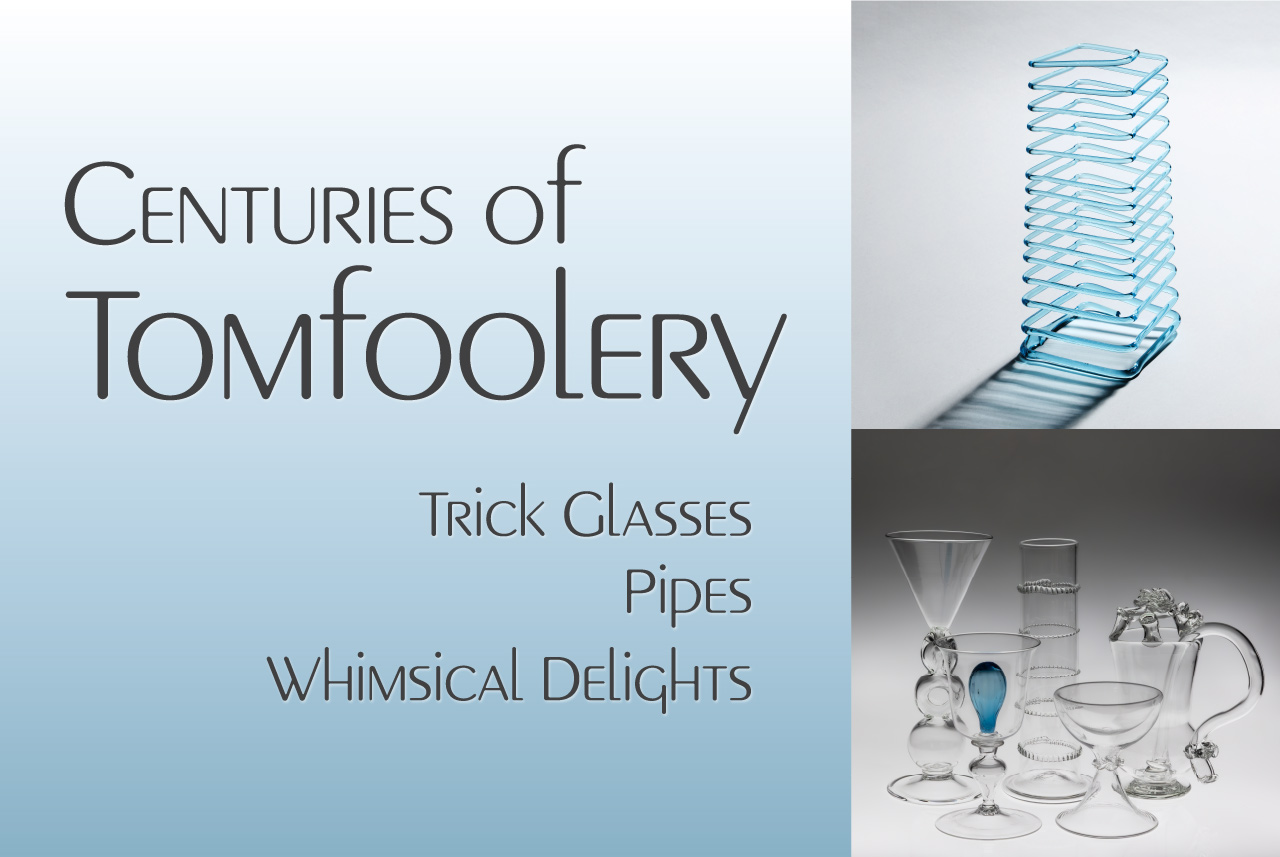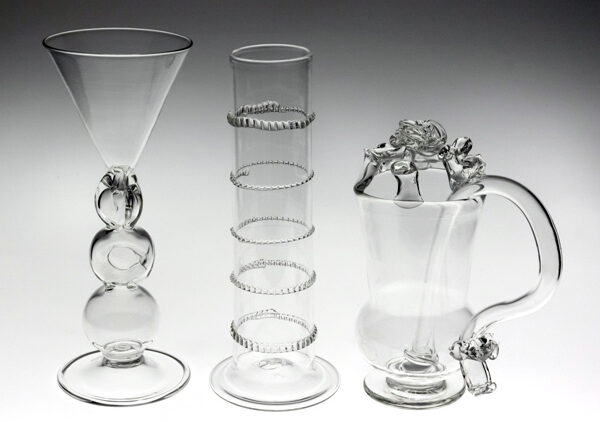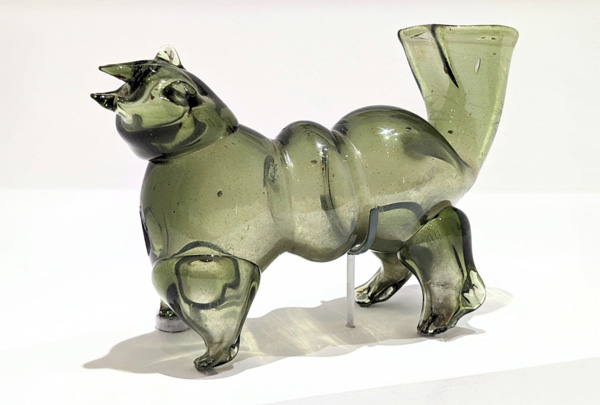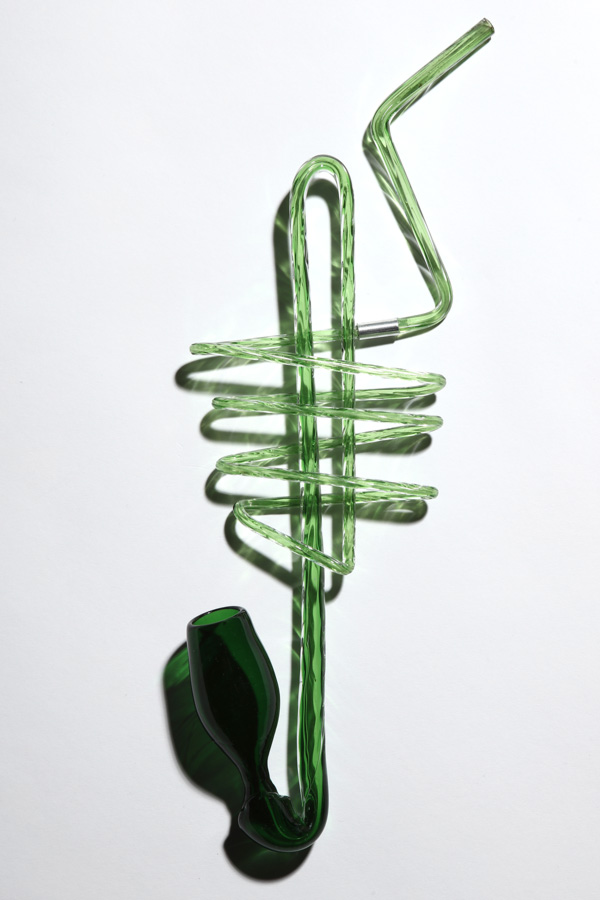
Centuries of Tomfoolery:
Trick Glasses, Pipes, & Whimsical Delights
April 4 through December 29, 2024
In the Museum of American Glass




Through the centuries, glassmakers have skillfully crafted vessels, pipes, and whimsical objects for communal entertainment. Whether intricately designed or deceptively simple, these devices are valued for more than their function and artistic merit. They prompt us to reflect on evolving cultural mores and society’s sense of humor at specific points in time. They reveal the ingenuity of glassmakers and their significant role in facilitating pleasurable social interactions. Centuries of Tomfoolery explores a fascinating group of objects through the lens of working artists who are compelled to recreate clever glassblowing feats from the past or push the boundaries of contemporary functional art.
It’s easy for us to imagine drinking games in the local bar or college dorm. This raucous and sometimes embarrassing behavior is neither new nor limited to a particular age group or social class. For more than a decade, several glass specialists—both historians and glassmakers—have focused their attention on European trick glasses made as early as the sixteenth century. The exhibit includes work by William Gudenrath and Marc Barreda, who use historically accurate techniques to replicate rare early glasses. Barreda coined the term “practical archaeology” to describe his investigative method of using duplicates to understand how trick glasses function without putting the fragile originals at risk.
Trick glasses often provide social amusement at an individual’s expense. For example, upon being handed a trick glass, the inexperienced merrymaker, who doesn’t know how to hold it, may be fooled into dousing themselves or having to swallow too much at once. The variety of trick glasses seems to be endless. Some are shaped like boots, guns, horns, or fanciful animals, while others produce obnoxious noises or optical illusions. In sharp contrast to the historical glasses, contemporary glassworkers—including former WheatonArts Fellow and Netflix Blown Away contestant Grace Whiteside—explore the concept of trick glasses with bold designs and a rich color palette.
Early American glass forms are rarely as intricate as European trick glasses, but they demonstrate a continuation of Old World glassmaking traditions. Factory glassblowers could express their creativity by making hats, horns, canes, and other whimsical objects for the entertainment of adults and children alike. These were usually made between shifts, at the end of the day, or to finish off a pot of glass. Glassblowers also made whimsies to show off their skills and impress factory visitors. Based upon archaeological evidence from Philadelphia’s Fishtown neighborhood, whimsies were ubiquitous in glassworker communities, where they were taken home, gifted, bartered, or sold.
Centuries of Tomfoolery features a very significant whimsey, a schnapshund (liquor dog), which is also considered a trick glass. Although a common German form, this example belonged to the granddaughter of Caspar Wistar, who hired German glassworkers and established America’s first commercially successful glass factory in 1739. It was located nearby in the township of Alloway, Salem County, New Jersey. The glass dog has remained at Wyck Historic House and Garden, Caspar’s wife’s ancestral home in the Germantown neighborhood of Philadelphia, for generations and has been attributed to the Wistarburg Glass Works.

Pipe smoking for rituals or recreation is one of the oldest communal activities. It is not surprising that this familiar form for smoking tobacco, cannabis, or other substances became part of the glassblower’s vocabulary for self-expression. European and American whimsical glass pipes from the 17th to mid-20th centuries echo historical forms and sometimes exhibit colorful decoration or exuberant stems. During the post-Vietnam era of the late 1970s, functional glass pipes made of durable, heat-tolerant borosilicate glass emerged as “paraphernalia.“ Initially a secretive underground movement, the number of flameworkers making pipes has grown exponentially in recent decades. Once relegated to headshops and subculture markets, pipes are now garnering the respect of top museums across the country. Like many trick glasses, the sculptural quality and technical brilliance of modern pipes often obscure the mechanics and functionality of the object. This is certainly true of the work of Joshua Opdenaker (JOP!), Daniel Coyle (Coyle), and Adam Whobrey (Hoobs), who are featured in the exhibit.
The Museum of American Glass at WheatonArts is open 11 a.m. to 4 p.m. Thursday through Sunday.
Click here for visitor information.

